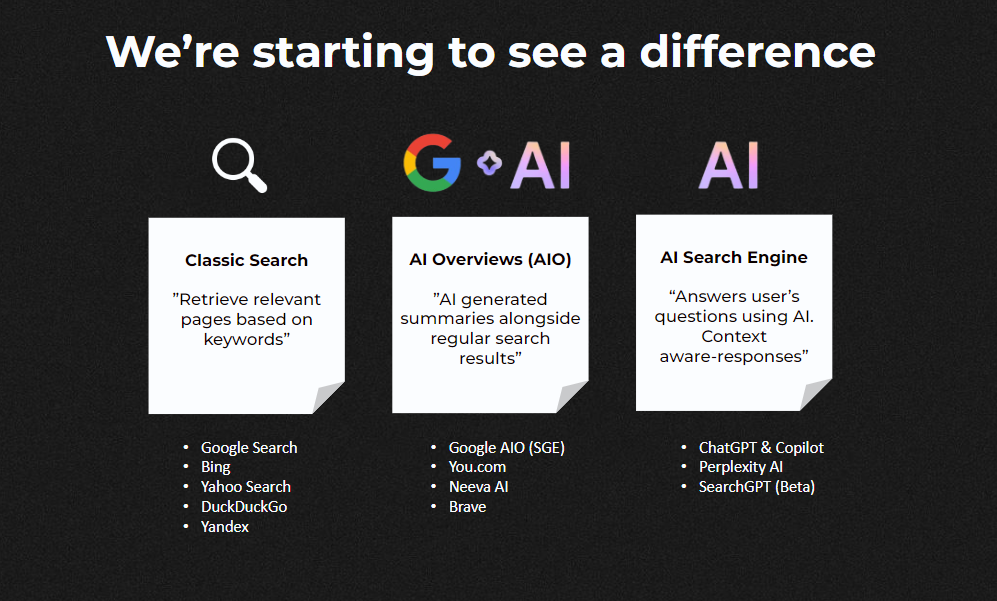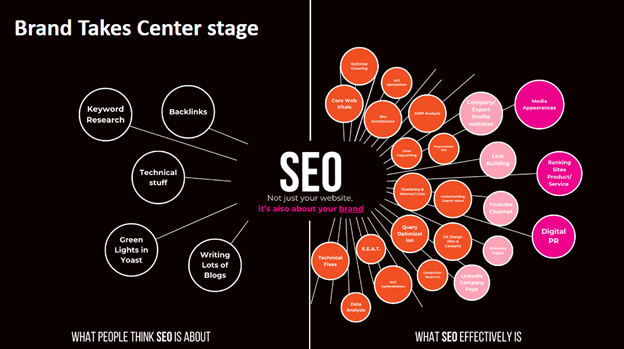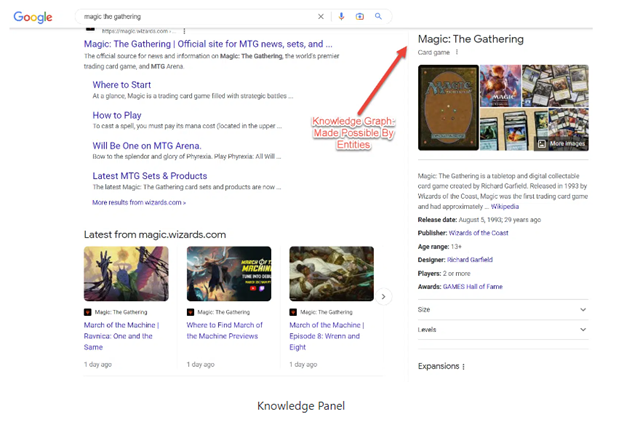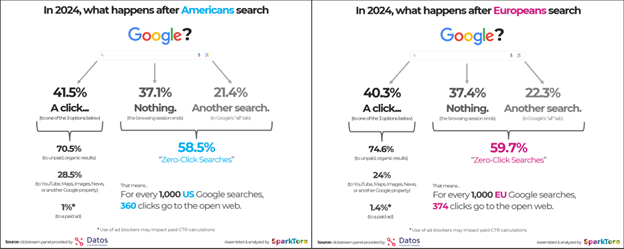The SEO landscape is undergoing a seismic shift. With the integration of artificial intelligence (AI) into search engines, the rules of the game have changed. Traditional SEO practices are no longer enough; ranking in AI-driven search now requires a more nuanced and strategic approach.

This article explores key strategies to rank effectively in AI search, why entities and brands are becoming critical, and how AI-powered search engines differ from their traditional counterparts. Additionally, we’ll highlight new tools that can help you track your performance in this evolving landscape.
Summary: Key Takeaways
- Already Ranking? Great News: If your site is already in the top 20 on traditional search engines, your chances of appearing in AI Overviews (AIO) increase significantly.
- Research Insights: Heatmaps from SearchAttention show that AI always reads the first paragraphs of your content. It seems to have a preference for bullet points.
- Brand is a Cornerstone: A May 2024 Google algorithm leak revealed that brand recognition now plays a much larger role in rankings.
- Bottom-Funnel Keywords: Want to avoid zero-click searches? Stick with keywords and landing pages that have a high buyer intention.
- New Tracking Tools: SEO platforms like SEranking are beta testing features that track rankings on AI search engines.
3 Types of Search Engines
The incorporation of AI into search engines has fundamentally altered how content is ranked and displayed. Let’s break down the key differences between traditional search engines and AI-driven platforms:

Classic Search Engines
- Examples: Google, Bing, Yahoo.
- Ranking Factors: These engines have historically relied on keyword optimization, backlinks, and technical SEO to rank pages.
Search Engines + AI Overviews
- Examples: Google’s AI Overviews
- Ranking Factors: These engines blend traditional factors with AI capabilities, offering quick summaries directly in search results by pulling key content from sites.
AI Search Platforms
- Examples: ChatGPT, Bing AI.
- Ranking Factors: These platforms are entirely AI-driven and provide comprehensive, long-form answers by drawing from multiple sources. They are designed to answer complex questions, using a deeper understanding of context and intent.
Ranking in AI Search: Strategies You Need to Know
1. Already Ranking in the Top 20? You’re in a Strong Position
If your website is already ranking within the top 20 on traditional search engines, you’re in a prime position to benefit from AI-generated results. Search engines using AI tend to pull content from the top-ranked pages for overviews and answer boxes. Staying within this range increases your visibility, not just on traditional SERPs, but in AI-driven summaries.
2. Heatmap Research: How AI Reads Content
Our research using SearchAttention’s heatmap tool has shown that only certain parts of your content is actually being read by an AI bot:
- First Paragraph: in 90% of the cases the heatmaps show that the AI always reads the first paragraph of your text. Adding a concise summary at the beginning of your content helps AI quickly understand and categorize the information.
- Structured with Bullet Points: Content broken into easy-to-digest lists tends to be noticed better.
- Headers & Subheaders: Using a logical hierarchy of headings helps AI navigate through your content more effectively.
- Ignored Paragraph: From the research it was also apparent that the AI also completely ignores large sections of a text. Which means that having a longer article doesn’t increase your odds of being considered relevant by AI. AI seems to love shorter texts which is contrary of what traditional SEO preaches.


3. Brands Are More Important Than Ever
A May 2024 leak from Google’s algorithm revealed that brand recognition is now playing a much more significant role in rankings. AI trusts established entities, meaning that websites with strong brand presence are more likely to rank higher.

To enhance your brand’s standing in AI search:
- Establish Authority: Create content that showcases your expertise and authority in your industry.
- Leverage Your Brand: Ensure your brand is consistently represented across all digital platforms.
4. SEO Entities: The New Currency
AI-powered search engines go beyond keywords and focus on “entities”—specific topics, people, or places that the engine can recognize and connect to user queries. Optimizing for entities can give you a significant boost in rankings. Here’s how:
- Identify Relevant Entities: Research the key entities related to your topic, such as influential figures, brands, or key concepts in your industry.
- Use Synonyms and Variations: AI recognizes relationships between terms, so don’t rely solely on the exact keyword. Use related phrases and synonyms to improve the content’s semantic relevance.
- Stay Updated: Ensure your content reflects the most current trends and updates related to your entities.

5. The Zero-Click Searches
The zero-click searches have become an increasing issue for organic traffic.This occurs when AI-driven search engines provide instant answers directly in the search results, reducing the need for users to visit websites, which lowers traffic and click-through rates. This trend is especially common with top-of-funnel, informational keywords.

To combat this, focusing on bottom-funnel keywords—terms that indicate a user is close to making a decision, like “buy” or “pricing”—is key. These searches often require more detailed information, such as product comparisons or pricing, that AI overviews can’t fully satisfy, making users more likely to click through to websites, increasing conversion potential.
6. Exact Match Blogs (EMBs): A Useful Strategy for Ranking in AI
One effective strategy for ranking in AI-driven search results is creating content that exactly matches the query a user is searching for. These are known as Exact Match Blogs (EMBs). By focusing your content around specific keywords or search phrases that users are likely to enter, you increase the chances of AI recognizing your content as the most relevant answer.
EMBs work well because they align closely with how AI identifies and pulls information for overviews or answer boxes. However, it’s important to ensure that the content provides real value and directly addresses the searcher’s intent, as AI now prioritizes quality and relevance over keyword stuffing.
7. Reverse-Engineer Directory Sites Referenced by AI Search Engines
NAP (Name, Address, Phone) and directory sites are experiencing a resurgence in importance, especially for ranking in AI. However, not all directories hold the same weight in AI-driven search results. A smart strategy is to reverse-engineer which directory sites are being referenced by AI search engines. By analyzing the sources that AI uses to pull information—whether it’s DesignRush, ProductHunt, review sites, or industry-specific directories—you can investigate which of those platforms to prioritize to ensure your business appears in the AI-generated overviews. Focusing on these select directories will improve your visibility and ranking in AI search results, as these trusted sources are key to establishing credibility in the AI ecosystem.
New Tools for Tracking AI Search Rankings
As AI continues to shape search results, traditional SEO tracking tools are evolving. Platforms like SEranking have started beta testing AI Optimization (AIO) rank features, which will help businesses monitor their performance on AI search engines.

These tools are essential for:
- Tracking AI Overviews Rankings: Understand how often your content is being pulled into AI-powered summaries and answer boxes.
- Monitoring Changes: Stay ahead of ranking fluctuations as AI-driven search becomes more dominant.
Conclusion: The Future of SEO in an AI-Driven World
Ranking in AI search engines is not just about keywords anymore. Today, SEO success depends on how well your content aligns with user intent, entity recognition, and brand authority. The rise of AI-driven platforms means that SEO professionals need to adapt to a more complex, content-focused environment.
Here are your next steps:
- Leverage Existing Rankings: Stay within the top 20 to increase your chances of AI-driven visibility.
- Optimize Content Structure: Use bullet points, headers, and summaries to make your content AI-friendly.
- Focus on Brand and Entities: Build your brand authority and optimize around relevant entities.
- Track Your Performance: Use new AIO rank tracking tools to stay ahead of the competition.
Thank you: Rick Tousseyn
